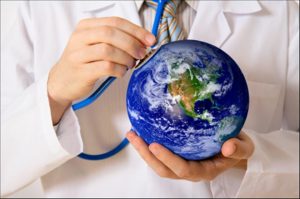
A scientific consensus exists that climate change is anthropogenically forced, with impacts on ecological systems and human health already in evidence. The grim toll is estimated at 300,000 deaths annually. Although climate change affects the entire world, it imposes vastly disproportionate burdens on low- and middle-income countries.
Systemic health effects include increasingly intense and more frequent natural disasters such as floods, heat waves, droughts, and wildfires resulting in injury, disease, and mass dislocations. Although causal relationships for any single event are difficult to establish, humanitarian crises are currently unfolding in Ethiopia, Papua New Guinea and Timor-Leste due to extreme weather events made more devastating by the 2015-2016 El Niño.
Climate change creates fertile conditions for, and alters the geographic range of, disease vectors such as mosquitoes, ticks, and rodents, bringing them into greater contact with humans that are naïve to the diseases they carry. Malaria and dengue, for example, are expected to move farther north. While the Zika “hot zone” in the United States is the Gulf Coast, climate change could push the mosquito vector to highly populated megacities such as New York. We are also seeing rises in food- and water-borne illness, such as cholera in the DRC. Climate change also affects air quality, as increased temperatures exacerbate air pollution, especially ground-level ozone and particulate matter. Rising temperatures and higher concentrations of CO2 will also increase the concentration of allergenic aeropollens.
Climate change increases the scarcity of clean water for drinking, sanitation, and crop irrigation, resulting in diarrheal illnesses. Ecosystem changes and water scarcity will also impair crop, livestock, and fishery yields, leading to increased hunger and famines. Climate change will play a major role in putting Africa under severe water stress as soon as 2020. These cataclysmic events could result in economic instability, mass migrations, civil unrest, and armed conflict in a time of competition for scarce resources.
Areas within some of the poorest regions, in Africa and South Asia, face reductions of staple food crops of 30% to 50% by 2020. The World Bank estimates that developing countries would bear 75-80% of the costs of climate change. Even 2°C warming above preindustrial temperatures – the minimum the world is likely to experience – could result in permanent reductions in GDP of 4-5% for Africa and South Asia. These devastating harms to health and society could be ameliorated given the political will and relatively modest costs.
Disadvantaged populations already live on the edge, with scarcity of water and food, as well as high infectious disease rates. The world’s poor also have the least capacity to ameliorate the devastation—weak health systems, poor infrastructures, less technological capabilities, and the fewest resources to adapt. Most are in tropical and subtropical regions. Climate change challenges the international community to find solutions, while also reducing vast global injustice.
Photo Courtesy of: www.abc.net.au



